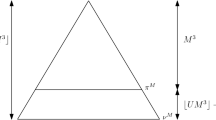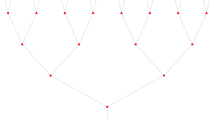Abstract
This paper is devoted to the study of random walks on infinite trees with finitely many cone types (also called periodic trees). We consider nearest neighbour random walks with probabilities adapted to the cone structure of the tree, which include in particular the well studied classes of simple and homesick random walks. We give a simple criterion for transience or recurrence of the random walk and prove that the spectral radius is equal to 1 if and only if the random walk is recurrent. Furthermore, we study the asymptotic behaviour of return probabilitites and prove a local limit theorem. In the transient case, we also prove a law of large numbers and compute the rate of escape of the random walk to infinity, as well as prove a central limit theorem. Finally, we describe the structure of the boundary process and explain its connection with the random walk.
Similar content being viewed by others
REFERENCES
Aomoto, K. (1984). Spectral theory in a free group and algebraic curves. J. Fac. Sci. Univ. Tokyo, Sect. 1A 31, 297–317.
Cannon, J. (1984). The combinatorial structure of cocompact discrete hyperbolic groups. Geom. Dedicata 16, 123–148.
Cartier, P. (1972). Fonctions harmoniques sur un arbre. Sympos. Math. 19, 203–270.
Cassi, D., and Regina, S. (1992). Dynamical phase transitions on comb lattices. Modern Phys. Lett. B 6, 1887–1891.
Dimca, A. (1977). Topics on Real and Complex Singularities, Vieweg, Braunschweig.
Drmota, M. (1997). Systems of functional equations. Random Struct. Algor. 10, 103–124.
Epstein, D., with Cannon, J., Holt, D., Levy, S., Paterson, M., and Thurston, W. (1992). Word Processing in Groups, Jones and Bartlett Publishers, Boston, MA.
Gerl, P. (1981). A Local Central Limit Theorem on Some Groups, The First Pannonian Symposium on Mathematical Statistics. In Révész, P. et al. (eds.), Lecture Notes in Statistics, Springer, Berlin, Vol. 8, pp. 73–82.
Gerl, P., and Woess, W. (1986). Local limits and harmonic functions for nonisotropic random walks on free groups. Probab. Theory Related Fields 71, 341–355.
Hersonsky, S., and Hubbard, J. (1997). Groups of automorphisms of trees and their limit sets. Ergodic Theory Dynam. Systems 17, 869–884.
Krámli, A., and Szász, D. (1983). Random walks with internal degrees of freedom. Z. Wahrscheinlichkeitsth. verw. Geb. 63, 85–95.
Kuich, W., and Salomaa, A. (1985). Semirings, Automata, Languages, Springer, Berlin.
Lalley, St. P. (1993). Finite range random walk on free groups and homogeneous trees. Ann. Probab. 21, 2087–2130.
Lalley, St. P. (2000). Random walks on regular languages and algebraic systems of generating functions, info preprint, University Chicago.
Levit, B., and Molchanov, S. (1971). Invariant chains on free groups with a finite number of generators (in Russian). Vestnik Moscov Univ. 6, 80–88.
Lyons, R. (1990). Random walks and percolation on trees. Ann. Probab. 18, 931–958.
Muller, D. E., and Schupp, P. E. (1985). The theory of ends, pushdown automata, and second order logic. Theoret. Comput. Sci. 37, 51–75.
Nagnibeda, T. (1997). On random walks and growth in groups with finitely many cone types, Ph.D. thesis, Geneve.
Saloff-Coste, L., and Woess, W. (1996). Computing norms of group-invariant transition operators. Combin. Probab. Comput. 4, 419–442.
Saloff-Coste, L., and Woess, W. (1997). Transition operators, groups, norms, and spectral radii. Pacific J. Math. 180, 333–367.
Sawyer, S., and Steger, T. (1987). The rate of escape for anistropic random walks in a tree. Probab. Theory Related Fields 76, 207–230.
Seneta, E. (1981). Non-Negative Matrices and Markov Chains, 2nd ed., Springer, New York.
Szegö, G. (1939). Orthogonal Polynomials, Amer. Math. Soc., Providence, Rhode Island.
Takacs, Ch. (1997). Random walk on periodic trees. Electronic J. Probab. 2, 1–16.
Takacs, Ch. (1998). Biased random walks on directed trees. Probab. Theory Related Fields 111, 123–139.
van der Waerden, B. L. (1939). Einführung in die algebraische Geometrie, Springer, Berlin.
Woess, W. (1984). A random walk on free products of finite groups. In Heyer, H. (ed.), Probability Measures on Groups, Springer Lect. Notes in Math., Vol. 1064, Springer, Berlin, pp. 467–470.
Woess, W. (1985). Random walks and periodic continued fractions. Adv. Appl. Probab. 17, 67–84.
Woess, W. (2000). Random Walks on Infinite Graphs and Groups, Cambridge University Press, Cambridge.
Author information
Authors and Affiliations
Rights and permissions
About this article
Cite this article
Nagnibeda, T., Woess, W. Random Walks on Trees with Finitely Many Cone Types. Journal of Theoretical Probability 15, 383–422 (2002). https://doi.org/10.1023/A:1014810827031
Issue Date:
DOI: https://doi.org/10.1023/A:1014810827031




